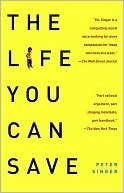More on this book
Community
Kindle Notes & Highlights
by
Peter Singer
Read between
March 19 - March 28, 2018
I propose a much easier target: roughly 5 percent of annual income for those who are financially comfortable, and rather more for the very rich.
What the individual ought to do, and what the best moral rule directs one to do, are not necessarily identical.
We should praise people for doing significantly better than most people in their circumstances would do, and blame them for doing significantly worse.
a “5.10.5.10” formula.
those in the top 5 percent, but not the top 1 percent, earn an average income of $210,000 annually, with a minimum income of $148,000.
If the donations are fully tax-deductible, they should be based on gross income, because they will in any case reduce the amount of tax paid.
5% of the first $148,000 and 10% of the remainder5%
these suggested levels of giving would yield a total of $471 billion a year for the world’s poorest billion people—not from all the world’s affluent people, but from just 10 percent of American families!
Surprisingly, Americans earning less than $20,000 a year actually give a higher percentage of their income—a substantial 4.6 percent— to charity than every other income group
And if the lower 90 percent of taxpayers were to give, on average, just 1 percent of their earnings, that, added to the suggested donations from the top 10 percent, would bring the total to around $510 billion.
extending the scheme I have suggested worldwide would provide more than $1.5 trillion annually for development aid.
Here’s a seven-point plan that will make you part of the solution to world poverty.
Feel good about being part of the solution.
If you and other well-off people in affluent nations were all to give, say, 5 percent of your income for the fight against global poverty, it would probably not reduce your happiness at all.
“Set your heart on doing good. Do it over and over again, and you will be filled with joy.”
“Helping others feels good and helps you feel good about yourself.”
when students donated, the brain’s “reward centers”—the caudate nucleus, nucleus accumbens, and insulae—became active. These are the parts of the brain that respond when you eat something sweet or receive money.
What greater motivation can there be than doing whatever one possibly can to reduce pain and suffering?
Ironically, given that so many people doubt the effectiveness of aid, aid targeted at saving the lives of children living in poverty is likely to be more cost-effective than emergency relief.
The point was, and remains, to bring about change in how we live.


